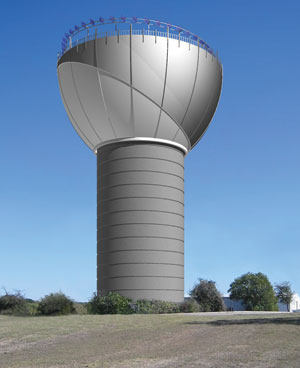The city will significantly expand this critical resource and set a new standard for environmental stewardship with the March completion of the 51st Street elevated reclaimed water storage tank. Austin Water Utility (AWU) initiated the project in 2007, and Landmark Structures of Fort Worth was awarded the job for design and construction, breaking ground in April, 2008.
 |
|
Crews erected and coated the steel tank at grade before hoisting, for easier access and greater safety. |
The $8.3 million investment, funded by reclaimed water fees, also includes related upgrades to the Walnut Creek Wastewater Treatment Plant. It will enable AWU to conserve 240 million gallons of water annually at inception, and 1.1 billion gallons annually at the eventual build-out of the reclaimed system. In addition to adding capacity to expand the service area, the design of the 2 million gallon, 170-foot-tall tank enables it to generate renewable energy, harvest rainwater and visually integrate with an adjacent master-planned residential and mixed-use urban redevelopment area.
Community Outreach
These advancements reflect a citizen-driven desire to create something unique and green that would contribute to building a sustainable, livable city and fit the environment. Based on input from neighborhood associations, AWU established a project advisory committee (PAC) early in the process to advise on the integration factors, and commissioned viewshed and real estate assessment studies that confirmed sight lines and concluded that there would be no adverse effects on surrounding property values. The PAC endorsed making the tank a visual landmark, and the utility proceeded with concept development.
Composite Tank
The decision to focus on a composite elevated tank (welded steel tank supported by a reinforced concrete pedestal) was reached after evaluating several other designs. Landmark developed a solution for the tank involving dramatic sweeping curves that met the aesthetic as well as constructability requirements. It also provided the large flat structural roof required for the renewable energy and rainwater collection features that were part of the specification. Architectural concrete was designated for the pedestal exterior, as it yields a clean, uniform surface quality to complement the distinctive tank contours and color scheme. Inside the pedestal, a planned pump station will be located on the ground level, with a chlorination room and other equipment ready for operation on the second level structural floor, taking advantage of the dry, protected usable space.
 |
|
Inside the pedestal, a planned pump station will be located on the ground level, with a chlorination room and other equipment ready for operation on the second level structural floor. |
The sustainability factors of the tank itself further enhance its role as part of the reclaimed water system. The second floor inside the pedestal consists of "green" concrete with high fly ash content, a recycled material. On the roof, slotted drains will capture more than 139,000 gallons of rainwater in a typical year and channel it directly into the tank for treatment, reducing runoff into local streams.
 |
|
The unique shape of the 51st Street reclaimed storage tank adds an imposing presence and visual landmark to the Mueller Area at the eastern edge of Austin. The rooftop accent ring will support 48 PV panels for solar power generation. |
The wraparound rooftop accent ring supports 48 photovoltaic panels that will generate more than 16,500 kWh of electricity annually, powering lighting and other equipment on the site, and returning the balance to the grid. This is projected to save 45,300 kWh of electricity at inception and reduce greenhouse gas emissions by 21.4 metric tons. AWU worked closely with sister electric power provider Austin Energy on implementing this feature, as both share in the city's commitment to a climate protection plan.
Once future stages of the reclaimed system are completed, they will more than quadruple capacity to 5.5 billion gallons per year.
Achieving Multiple Goals
"Our reclaimed system has been essential to meeting customer demand in the absence of major new sources of supply. In the drought year of 2009, we used 2.0 billion gallons of reclaimed water, significantly more than in previous years. This project not only advances our capabilities, but gives the whole initiative greater visibility," said Dan Pedersen, reclaimed program manager, Austin Water Utility. "We're very pleased with the partnerships we formed to achieve it – from the community groups right on through to the design and construction team."
Eric Lamon, Landmark vice president, added that the project provided both challenges and opportunities.
"We fulfilled all of the structural, functional and aesthetic objectives, while leveraging a lot of proven practices to help manage schedule, cost and quality," he said. "At the same time, the owner's and community's commitment and vision enabled us to change the state of the art and move it forward, which was very rewarding." WW
More
WaterWorld Current Issue Articles
More
WaterWorld Archives Issue Articles